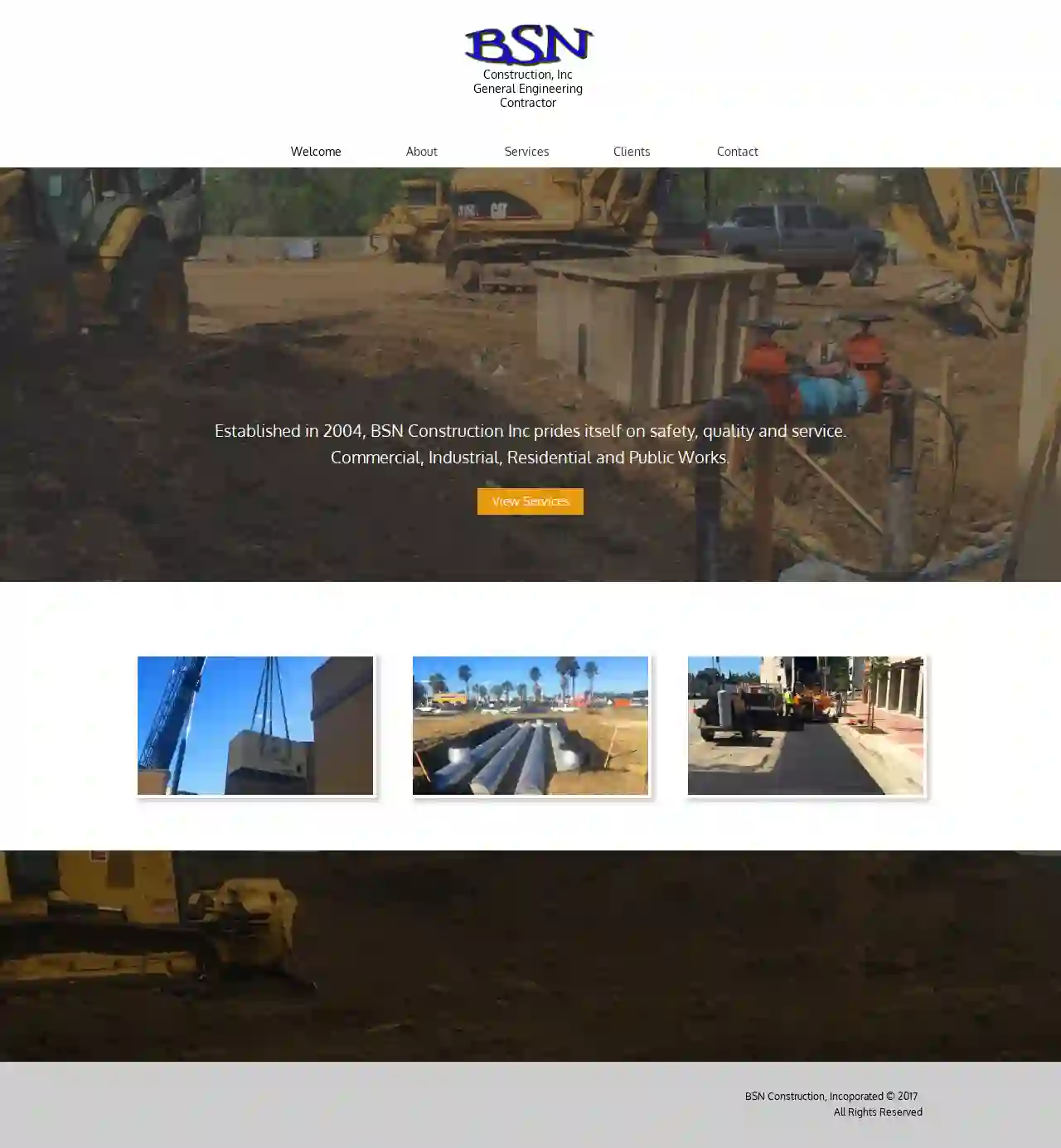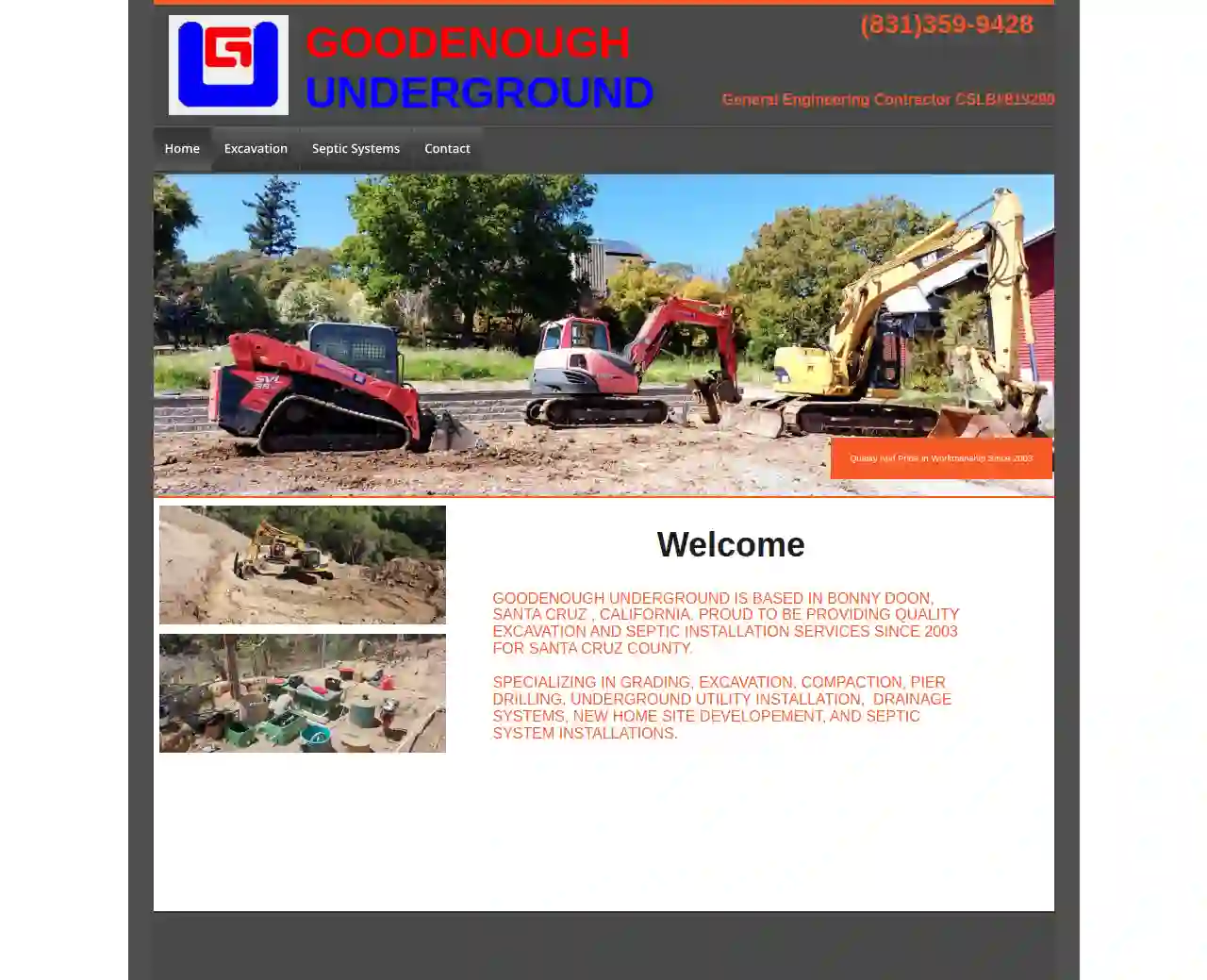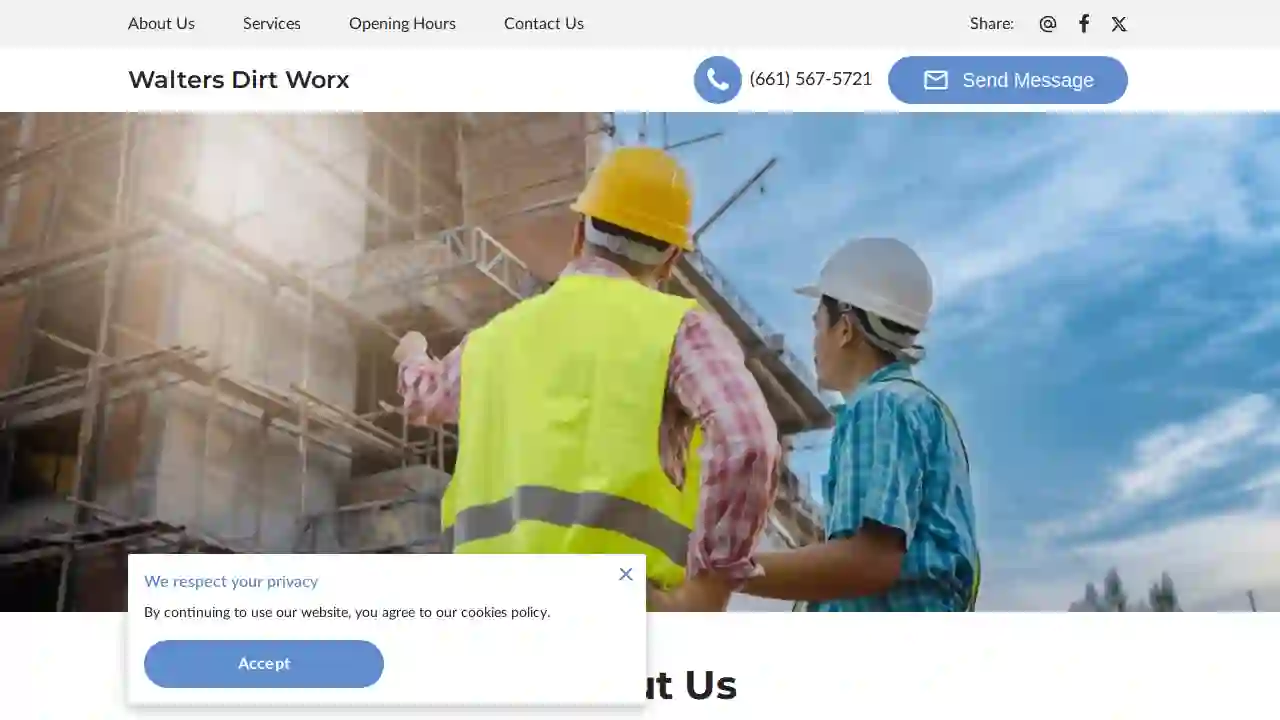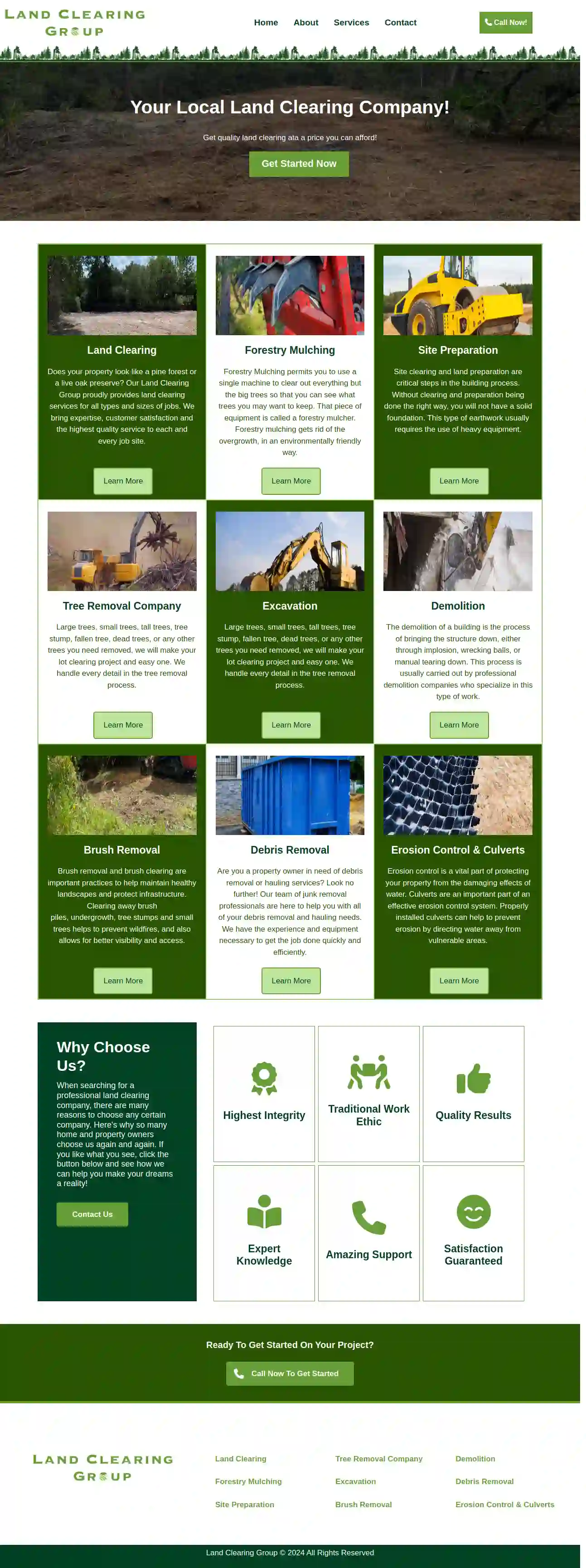Excavation Contractors Carlsbad
Find Excavation Companies in Carlsbad
Get 3 FREE Excavation Services quotes for your project today! Compare profiles, reviews, accreditations, portfolio, etc... and choose the best deal.

Souza Construction & Electric
52 reviews586 So. Farmersville Blvd., Farmersville, 93223, USSouza Construction Inc. is a growing construction business, striving ever forward to become a premier general contractor. From our beginning as a “one-man show”, until our present state as a “multi-faceted” team, one thing has remained constant, a commitment to customer service. It is this commitment that has helped Souza Construction Inc. nearly double its sales every year for the last four years. We firmly believe that it will be this continuing commitment that will assist us in continuing this phenomenal growth pattern. Essential to this excellent service are our capabilities as a builder and a business. THE SOUZA COMMITMENT Souza Construction Inc. has committed itself to recruiting and training leaders in both the construction and professional world. Assembling a team of this caliber is not a quick or simple process, but requires diligent research, highly refined discernment, and continuous assessment. However, it is just this level of commitment and attention to detail that sets us apart. Souza Construction Inc. has made this our primary goal: understanding our customers and their needs, utilizing excellence in the field and in administration, and combining this with an unwavering commitment to customer satisfaction; this is Souza Construction Inc.
- Services
- Why Us?
- Testimonials
- Gallery
Get Quote
BSN CONSTRUCTION, INC
1Suite 200, 1000 Old Country Rd, Garden City, 11747, USBSN Construction: Your Trusted Partner for Quality Construction BSN Construction is a family-owned and operated business with over 20 years of experience in the construction industry. We are committed to providing our clients with the highest quality construction services at competitive prices. We specialize in a wide range of construction projects, including residential, commercial, and industrial. We are also a licensed and insured contractor, so you can rest assured that your project is in good hands. We understand that building or renovating your home or business is a big decision. That's why we take the time to listen to our clients' needs and work with them to develop a plan that meets their specific requirements. We are also committed to providing excellent customer service and keeping our clients informed throughout the entire construction process. If you are looking for a reliable and experienced construction company, look no further than BSN Construction. We are confident that we can provide you with the quality construction services you need to make your project a success.
- Services
- Why Us?
Get Quote
Esm Improvement
52 reviewsLos Angeles, US- Services
- Why Us?
Get Quote
GOODENOUGH UNDERGROUND INC.
57 reviewsBonny Doon, USGOODENOUGH UNDERGROUND IS BASED IN BONNY DOON, SANTA CRUZ , CALIFORNIA. PROUD TO BE PROVIDING QUALITY EXCAVATION AND SEPTIC INSTALLATION SERVICES SINCE 2003 FOR SANTA CRUZ COUNTY. SPECIALIZING IN GRADING, EXCAVATION, COMPACTION, PIER DRILLING, UNDERGROUND UTILITY INSTALLATION, DRAINAGE SYSTEMS, NEW HOME SITE DEVELOPEMENT, AND SEPTIC SYSTEM INSTALLATIONS.
- Services
- Why Us?
- Our Team
- Gallery
Get Quote
Excavating Contractor Los Angeles
59 reviewsLos Angeles, USWelcome to Bobcat Excavating Services Los Angeles As an excavation services and bobcat services provider in Los Angeles, we at BSLA – Bobcat Services Los Angeles help our clients with any processes that involve removal of earth from the ground, transfer of earth from one site to another, backfilling of earth to previously excavated spaces, and modification of sites to suite various clients’ needs. Are you building or remodeling your outdoor space? Chances are that we can be of help. If you searched for “excavators near me” for you got to the right place! We are experts when it comes to excavation, bobcat services, compacting, filling and grading. We work on residential sites, commercial sites, and industrial locations. We are licensed and insured and all our machine operators are vigorously skilled in handling our heavy machinery and providing precision results.
- Services
- Why Us?
- Gallery
Get Quote
Walters Dirt Worx
1Bakersfield, California, USAbout Us Here at Walters Dirt Worx we offer an exceptional range of construction services in the greater Bakersfield area. From concrete foundation work to excavation, brickwork, and architectural advice, our experienced builders understand the best solutions that work for you. We provide any heavy equipment required work with outstanding results and unbeatable pricing. We’re all dedicated to our roles and work hard to get the job done. Give us a call at +16615675721 so we can discuss any of your construction needs. We always use the highest quality materials during the construction of your outdoor space and our expert designers utilise industry-leading tools. This mix of top equipment and unmatched skill has allowed us to succeed by supplying our clients with services they won’t forget. Not convinced? Think we’re all talk? Read our reviews and get in touch to see what we can deliver. You will not be disappointed. Are you putting together a blueprint for a property or building? If you are, we can deliver expert excavation services to prepare a new build for the foundations and basis of your construction. We understand the demands that are placed on you, so work with your goals in mind to prepare and excavate the land by the most efficient means possible, using a combination of manpower and highly technical heavy-duty vehicles.
- Services
- Why Us?
Get Quote
Land Clearing Group
55 reviewsOrange, USAbout The Land Clearing Group We help homeowners and businesses clear and prepare their property for the next phase of their project. Whether you need simple brush clearing or a total clear and site prep, we are here to help. Land Clearing Group is more than just a single company, we are composed of a large team of industry professionals that can handle any land clearing project; no matter the task. Our team of pros gives property owners a combined 50+ years of experience. We have worked in land projects across the state of Florida, Land Clearing Central Florida is quickly become the industry leader in customer satisfaction.Understand that this is our top priority on all land clearing solutions. Operating with such high corporate standards is not an easy task to achieve and can be solely attributed to the multiple professionals involved. Since the start of the company, we have operated on 3 principles which are visible on every project we do: We love this stuff! We will show up at each job: on time, ready to work and have fun. There will be crystal clear communication with the property owners at all times: before, during and after all projects. Your property will always be treated the same way we would treat our own property.
- Services
- Why Us?
- Gallery
Get Quote
CBT Builders
4.713 reviews2501 E Commercial Blvd, Suite 211, Fort Lauderdale, 33308, USCommitted to quality and timing Building excellence on schedule - our unwavering dedication to quality craftsmanship and timely delivery sets us apart. Maintain your property's value Protect your investment with our expert maintenance services - we help you preserve your property's value for the long term. Safety is our #1 priority At our construction company, safety always comes first - we prioritize the well-being of our team and clients above all else. Why us? Our team comes with the experience and knowledge We are a licensed, bonded, and insured State Certified General Contractor. The CBT team has been enhancing condominiums, hotels, and commercial properties in South Florida with decades of experience. We are committed to quality and timely job completion. Our workforce is continuously training to learn new techniques to constantly improve individual leadership and knowledge about products and current industry standards. By investing in all these things, we ensure that our personnel are up to date on the latest technologies, achieve consistent results, and promote a healthy and safe work environment. Recent Projects Harborview Hospitality Plaza at Oceanside Townsend Condominium Safety is #1 Having a solid track record of OSHA (Occupational Safety and Health Administration) compliance, CBT BUILDERS holds the safety of its employees and clients to the highest priority. As part of a strict safety program, our company personnel hold OSHA training certifications and we hold regular safety meetings and employee training. In addition to meeting OSHA standards, our access equipment is inspected by certified riggers on a regular basis. In order to ensure a safe work environment on all projects, CBT uses the latest specialized equipment, constructs elaborate overhead pedestrian and vehicular safety systems, or constructs pedestrian traffic tunnels. Safety Systems As a rule, safety begins at the top when it comes to accessing building facades and using rope-descent systems. With CBT Safety Systems, our goal is to provide buildings with facade access and fall-protection systems that meet building owner regulations and ensure maximum safety and operational functionality for contractors. Ensuring effective and compliant rooftop safety systems requires a specialized approach, due to each building's unique features. CBT Building Services provides turn-key solutions tailored exactly to the needs of each project.
- Services
- Why Us?
- Our Team
- Gallery
Get Quote- El
Elite Metal Building and Roofing
429 reviewsOakland, US- Services
- Why Us?
- Gallery
Get Quote 
Heavy Road Industries
11 reviews3525 S. Maple Ave, Fresno, 93725, USAbout us Where we come from, who we are and what we are made of! Who We Are David Cruce grew up working for his fathers grading and paving company located in the foothills of Yosemite National Park. David learned real fast what hard work and determination meant. Starting as a laborer and learning the ropes of how the business ran, he soon moved up to running projects at the age of 18 during the day and estimating for his father at night. David immersed himself in the businesses and wanted to better the company through his hard work. When David turned 20 he started a new path with a company doing the same field in Fresno, CA. Starting out operating paving machines, David quickly moved up into the office as dispatch and Project Engineer. Through the years, David learned and worked his way up the ranks with a few other companies until he decided the industry needed something new. Our Vision To bring value to our clients through more durable solutions. Our Mission Providing sustainable cost-effective solutions through engineering an innovation. Our Values Education Innovation Leadership Can Do Attitude Our People Companies do not succeed through just a few people. They succeed through the entire team. We know that establishing a strong team and focusing on only making it stronger will lead to our legacy. Meet the Team Our crews and our office staff are dedicated to educate, inspire and advise about our process and our advanced solution to the civil construction industry. Providing your company with information on how to save money, get a longer lasting product and provide a better eco-friendly solution. President David Cruce Chief Estimator Chris Hickey Office Manager Kris Gag
- Services
- Why Us?
- Our Team
- Gallery
Get Quote
Over 3,943+ Excavation Pros onboarded
Our excavation providers operate in Carlsbad and surrounding areas!
ExcavationHQ has curated and vetted the Best Excavation Pros near Carlsbad. Find a top & trustworthy pro today.
Frequently Asked Questions About Excavation Contractors
- Project Size and Scope: Larger, more complex excavations naturally take longer.
- Soil Conditions: Rocky or challenging soil types can slow down progress.
- Site Accessibility: Limited access might require more time for maneuvering equipment and hauling materials.
- Weather: Inclement weather can cause delays.
- Permitting and Inspections: Waiting for permits or inspections can extend the timeline.
- Determining Soil Suitability: Assessing whether the soil can support the intended structure or load.
- Recommending Foundation Types: Advising on the appropriate foundation design based on soil characteristics.
- Addressing Drainage and Erosion Issues: Providing solutions to manage water runoff and prevent erosion.
- Evaluating Slope Stability: Assessing the risk of landslides or soil movement on slopes.
- Building on challenging soil types (expansive clay, loose sand, etc.)
- Constructing large or complex structures
- Excavating near slopes or retaining walls
- Addressing drainage or erosion concerns
- Project Type and Size: Ensure the contractor has experience handling projects similar to yours in scale and complexity.
- Reputation and Reviews: Check online reviews and testimonials, and request references from previous clients.
- Licensing and Insurance: Verify that the contractor is properly licensed and insured to protect you from liability.
- Equipment and Resources: Confirm that they have the necessary equipment and resources for your project's needs.
- Communication and Transparency: Choose a contractor who communicates clearly, provides detailed estimates, and keeps you informed throughout the project.
- Safety Record: Inquire about their safety protocols and track record to ensure a safe work environment.
- Price: While price is important, it shouldn't be the only deciding factor. Balance affordability with experience, reputation, and quality of service.
- Sloped Property: Your property has a significant slope, making it prone to soil erosion or landslides.
- Creating Usable Space: You want to level off a sloped area to create a flat surface for patios, gardens, or other outdoor spaces.
- Preventing Damage: Erosion is threatening existing structures, driveways, or walkways.
- Landscaping Features: You're incorporating tiered gardens, raised beds, or other landscaping elements requiring soil retention.
How long does an excavation project take?
What is a soil engineer, and do I need one?
How do I choose the right excavation contractor for my project?
How do I know if I need a retaining wall?
How long does an excavation project take?
- Project Size and Scope: Larger, more complex excavations naturally take longer.
- Soil Conditions: Rocky or challenging soil types can slow down progress.
- Site Accessibility: Limited access might require more time for maneuvering equipment and hauling materials.
- Weather: Inclement weather can cause delays.
- Permitting and Inspections: Waiting for permits or inspections can extend the timeline.
What is a soil engineer, and do I need one?
- Determining Soil Suitability: Assessing whether the soil can support the intended structure or load.
- Recommending Foundation Types: Advising on the appropriate foundation design based on soil characteristics.
- Addressing Drainage and Erosion Issues: Providing solutions to manage water runoff and prevent erosion.
- Evaluating Slope Stability: Assessing the risk of landslides or soil movement on slopes.
- Building on challenging soil types (expansive clay, loose sand, etc.)
- Constructing large or complex structures
- Excavating near slopes or retaining walls
- Addressing drainage or erosion concerns
How do I choose the right excavation contractor for my project?
- Project Type and Size: Ensure the contractor has experience handling projects similar to yours in scale and complexity.
- Reputation and Reviews: Check online reviews and testimonials, and request references from previous clients.
- Licensing and Insurance: Verify that the contractor is properly licensed and insured to protect you from liability.
- Equipment and Resources: Confirm that they have the necessary equipment and resources for your project's needs.
- Communication and Transparency: Choose a contractor who communicates clearly, provides detailed estimates, and keeps you informed throughout the project.
- Safety Record: Inquire about their safety protocols and track record to ensure a safe work environment.
- Price: While price is important, it shouldn't be the only deciding factor. Balance affordability with experience, reputation, and quality of service.
How do I know if I need a retaining wall?
- Sloped Property: Your property has a significant slope, making it prone to soil erosion or landslides.
- Creating Usable Space: You want to level off a sloped area to create a flat surface for patios, gardens, or other outdoor spaces.
- Preventing Damage: Erosion is threatening existing structures, driveways, or walkways.
- Landscaping Features: You're incorporating tiered gardens, raised beds, or other landscaping elements requiring soil retention.